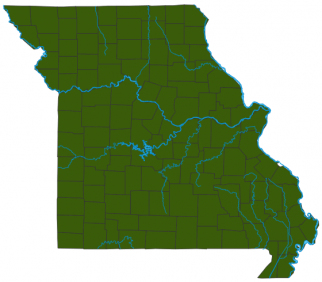Media

Scientific Name
Tritogonia verrucosa
Family
Unionidae (freshwater mussels) in the phylum Mollusca
Description
Shell is heavy, compressed and elongate; covered with pustules (knobs); pronounced, knobby posterior ridge with flutings and folds extending to margin. Umbo is slightly elevated above hinge line, turned forward. Epidermis is light green to brown in juveniles and brown or black in adults. Inner shell beak cavity moderately deep; pseudocardinal teeth large and serrate; lateral teeth long, straight and heavy; nacre (lining) usually white, iridescent posteriorly.
Size
Adult length: 4-7 inches.
Where To Find

Widespread, sometimes locally common.
Habitat and Conservation
Medium to large rivers with moderate current in stable gravel and sand or mud. Has been found on almost any kind of substrate.
Food
Algae and fine particles of decaying organic matter; extracts nutrients and oxygen from water drawn into the body cavity through a specialized gill called the incurrent siphon; sediment and undigested waste are expelled through the excurrent siphon.
Status
Common, although degrading water quality and watershed destabilization interfere with the survival of this and all freshwater mussels.
Life Cycle
Life Cycle
Males release sperm directly into water. Females downstream siphon sperm into the gill chamber, where eggs are fertilized. Eggs mature into larvae (called glochidia), which discharge into the water and attach to host fish. The tiny mussel eventually breaks away and floats to the bottom of the stream, and the cycle repeats.
Human Connections
Mussels are excellent biological indicators of water quality because they are long-lived and relatively immobile, accumulating contaminants in water that can be scientifically analyzed. This species was used in the button industry and also in the Japanese cultured pearl industry.
Ecosystem Connections
Mussels act as nature's “vacuum cleaners,” filtering and cleansing polluted waters. They are also an important food source for other species in the aquatic environment.
Title
Media Gallery
Image

Credit
Jim Rathert
Right to Use
Image

Title
Similar Species
About Aquatic Invertebrates in Missouri
Missouri's streams, lakes, and other aquatic habitats hold thousands of kinds of invertebrates — worms, freshwater mussels, snails, crayfish, insects, and other animals without backbones. These creatures are vital links in the aquatic food chain, and their presence and numbers tell us a lot about water quality.





















